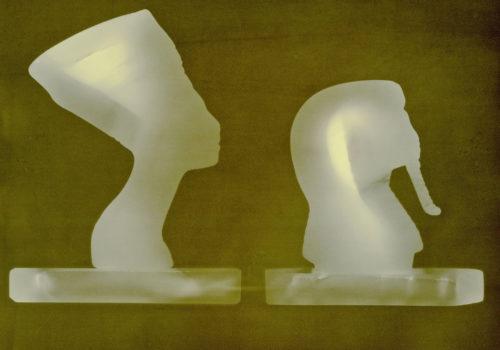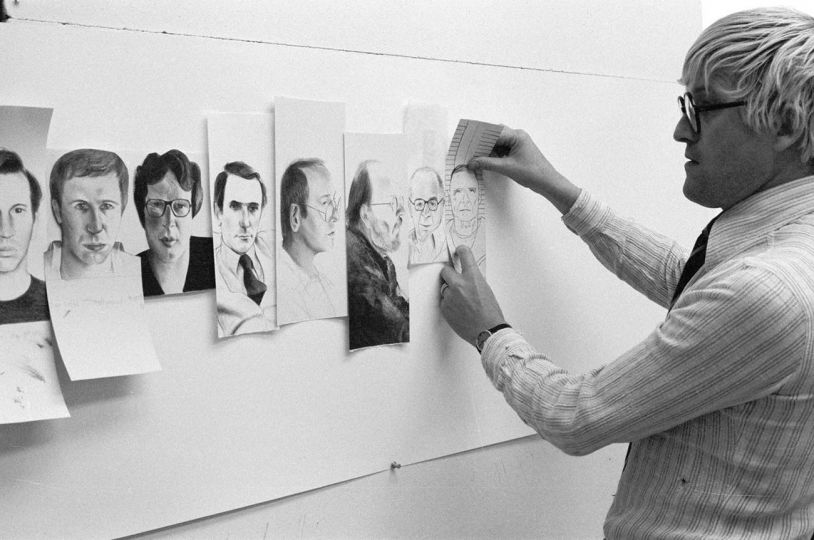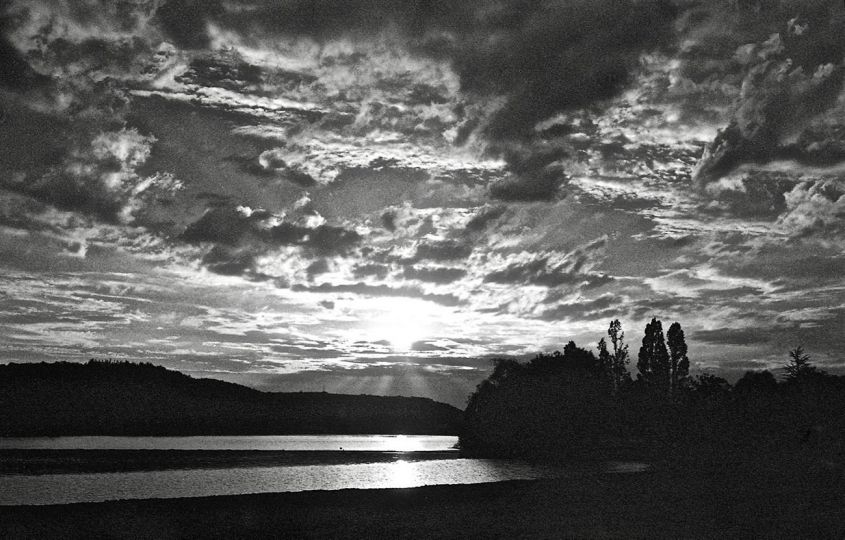In this chapter, Jacques Revon explores printing on gelatin-bromide paper of photograms developed in a tray in alternative developers made with coffee, wine and sage.
“Film photography is initially authentic because the negative remains, even if one day it is scanned and therefore becomes digital at the risk, as we know, of being later manipulated.” – JR
By continuing my tests and research into development in so-called ecological alternative developers and, after having tested in these developers several films and films of different sensitivities and in various conditions, outdoors as well as indoors, I wanted for the first time develop in these developers, paper prints whose emulsions are coated on barium or RC supports.
My first observations.
I realized quite quickly that this work turned out to be more complex.
Indeed, by definition photographic paper does not react at all like film.
It is already not transparent like a film support or that of a film. The supports are opaque this time. For these tests, I used very well preserved old papers from the Leonar brand in barium cardboard (FB) and waterproof coated resin (RC) of the Ilford Ilfospeed type. (photo)
The sensitivity of silver emulsions coated on these paper supports is very low, between 3 and 5 ISO. In my tests, I initially had to think about how to approach and resolve these parameters different from those adapted to emulsions coated on a transparent film support.
After a first test of classic printing, that is to say with an average projection time of 30 seconds of the light of my enlarger, through a negative of normal density, at full aperture f 5.6 then developed in my bowl filled with my alternative developer of coffee at 21°, I noticed that nothing or not much was happening. No apparent image on my sheet despite a significant increase in development time (7 minutes instead of 2 to 3 normally).
During another test, I decided to project my negative onto gelatin-bromide paper with a thick support, programming an exposure time of 2 minutes. Then, this time I developed it, at a high temperature of 27°, choosing the same development time, 7 minutes, while hoping that there would be no background veil. ( photo ).
To maintain my developer at this temperature as there is no heating element, I had to place my 18X24 format bowl in a second, slightly larger bowl, to create a bain-marie, the latter being filled with hot water. at 32°, thus allowing me to maintain approximately the chosen temperature of 27° (photo).
I concluded and, as you can imagine, this approach was not very easy to manage, the result not necessarily becoming reproducible. (photo). Added to this was too long an exposure time with consequences that one can imagine: the lamp of my enlarger excessively heated the condenser and the bulb risked “burning out”. As for my coffee developer, it oxidized too quickly with the necessary agitation of my sheet of paper; result in a loss of his qualities as a developer.
After these observations, I decided to postpone my tests for a while.
A little later, I therefore opted for another operating method, this time choosing to make photograms. The exposure method is carried out directly by contact, so no more negative in the enlarger. (photo).
For my printing tests, I exposed the 18X24 sheet of paper, with the projection of the light beam directly above the objects that I had chosen and previously placed and positioned on the paper. I developed these prints first in coffee, then in wine and finally in a Sage developer. (Pictures).
Of course, I also had to expose the paper a little longer but in this case, the exposure times became more reasonable, from 30 seconds to 1 minute 30 depending on the type of paper chosen. RC or barium (photos).
The actual development was carried out as previously, always at a high temperature of 27° with the use of my hot water bath at around 30°, in which I positioned the bowl by flotation. from my alternative developer. (balance).
Tip: as you develop, don’t forget to check the degree and, if necessary, add a little hot water to maintain the recommended temperature, if like me you don’t have a heating element.
The duration of development is still around 7 minutes, but we are here in a completely different approach, that of creative research, and not in the situation of a print to be produced in a routine manner.
Only the criterion of use and therefore oxidation of the developer caused by the number of paper surfaces developed should impose a maximum usage time for your alternative developer.
I invite you to work in a rational and reproducible way, noting the number of sheets of the format that you develop to obtain satisfactory results, and to subsequently define a working basis.
Remember that with the agitation of the sheets in your tank, the oxidation of an alternative developer accelerates, compared to the development of a film in a closed tank or in a so-called standard developer. Finally, don’t forget gloves or tongs to handle your products.
Be aware that alternative ecological developers, whatever they may be, are preservative-free, and therefore they oxidize quite quickly, they cannot be preserved. You will also note that here, the prints acquire, thanks to these different alternative developers, a color which is impregnated in the emulsion and in the barium support, a color which depends on the ingredient of the developer which you have chosen to use. We thus obtain a “shift” which again is natural and not unpleasant. The results are interesting and pleasing to the eye.
Finally, this affordable and creative alternative ecological approach to photograms could, in my opinion, be offered to students for a discovery of the magic that is film photography.
Method for making an alternative developer with Sage intended for paper development.
Two preparations, A and B.
18 g of aromatic dried sage leaves, without the stems, will be necessary here.
A. Decoction of the aromatic herb Sage, preparation A.
- Put the 18 g of dried sage leaves in 700 cc of cold demineralized water then let them soak for 10 minutes.
- Then bring everything to a boil, and let the decoction take place slowly without boiling, for 10 minutes. (stir the leaves from time to time).
- Allow the liquid obtained to cool, then filter it once using a fairly fine strainer.
B. Dissolution of preparation B.
Gently dissolve in 400 cc of demineralized water in order at a temperature of 22°, the two products necessary here to make the developer.
Namely: 95 grams of sodium carbonate, then 15 grams of vitamin C.
When developing a sheet of photographic paper, it is not necessarily necessary to add iodized salt as when developing film or film in an alternative developer.
Then, filter the preparation well.
C. Mix the two preparations A and B well then filter the ready-to-use mixture once again.
D. Develop the paper at 27° with a hot water bath at 30° to maintain the developer temperature or use a small heating resistor to regulate the temperature.
Jacques Revon
Journaliste honoraire, auteur, photographe.
https://fr.wikipedia.org/wiki/Jacques_Revon
















